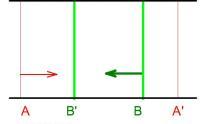
You are here: Building the Model: Advanced Elements > Material Handling Systems > Crane Systems > Case Examples of Zone Claims
The following cases illustrate specific situations with examples:

Bridge B starts moving first, from [B] to [B'] and claims the zone [B'~B] in the ¨ direction. Bridge A wants to move from [A] to [A'] in the opposite direction. If the move priority of A is less than or equal to the move priority of B, we let bridge A start moving towards [B' - bridge separation] only. If A has a higher move priority, B is stopped immediately and sent back to [A' + bridge separation]. In the latter case, A may queue up behind B.
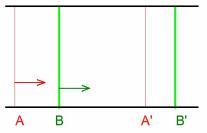
Bridge B starts moving first, from [B] to [B'], then bridge A wants to move from [A] to [A']. Bridge B claims zone [B~B'] in the Æ direction. Since bridge A wants to move in the same direction and their destinations do not conflict (assuming that B'-A' is greater than the bridge separation), bridge A moves all the way. If B has already cleared the zone [A~(A' + bridge separation)] by the time A wants to start moving, A moves independently. Otherwise, A may queue up behind B. (If the distance B'-A' is less than the given bridge separation and the move priority of A is greater than the move priority of B, bridge A will push away bridge B, and crane B will not respond to the request while passing over [B']).
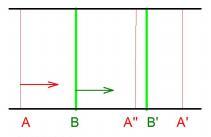
Bridge B starts moving first, from [B] to [B'], then bridge A wants to move from [A] to [A']. Bridge B claims the zone [B~B'] in the Æ direction. Since bridge A wants to move in the same direction and their destinations do conflict, priorities will be considered. If the move priority of A is not greater1 than the move priority of B, bridge A starts moving towards [A'' = B' - bridge separation] only. Otherwise, A will push B away, and B will not respond to the request while passing over [B']. In both cases, A may queue up behind B.
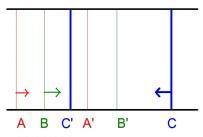
Bridge B starts moving first from [B] to [B'], claiming zone [B~B'] in the Æ direction. Bridge A wants to move from A to A' and starts moving behind B. Bridge C wants to move in the opposite direction with a higher move priority than both of the other bridges. ProModel interrupts bridges A and B and lays a new course for both bridge B [B'' = C' - bridge separation] and bridge A [A'' = B'' - bridge separation]. In this case, B may queue up behind A, and C behind B.
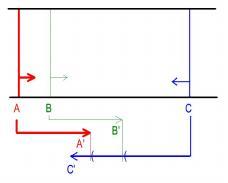
This is an extension of Case 4. Assume that the move priorities for crane bridges A, B, and C are 3, 1, and 2 respectively. When bridge C tries to claim zone [C'~C] in the ¨ direction, it faces an "effective priority" of 3 and is unsuccessful in its original claim, so it starts moving towards [B' + bridge separation]. Bridge B goes outside the effect of bridge A in the second part of its movement, [(A' + bridge separation) ~ B'] at time t0. However, bridge C does not override bridge B and start moving towards [A' + 2 * bridge separation] until the first "reclaim trigger event2" after time t0.
If ProModel rejects the original claim of crane A, crane A claims the largest available portion of the original zone, and implements the procedure described below to move its bridge through the subset zone. The crane waits until a "reclaim trigger event" occurs, and then repeats the claim attempt to let its bridge traverse the remaining distance. The hoist, on the other hand, moves directly to its relative destination on the bridge, independent of the bridge zone claim results. In case of bridge interruption, the hoist does not stop moving. Therefore, for any particular crane move, the combined trajectory of hoist and bridge may change depending on zone availability at the time of the claim.
If crane A accepts the claim attempt, all cranes inside the claimed extended zone bump away at the time of the claim. This claim also prevents any other cranes with move priority less than or equal to the move priority of A from entering the claimed zone in conflicting directions.
Zone Claim Notes
Zone Claim Notes
1. A crane cannot do a pickup or deposit while another crane pushes it away, even though the request might be on its way.
2. When you interrupt a crane bridge and ask it to make a new claim (or update its claim), its speed is reset to zero and ProModel re-evaluates its mobility characteristics. ProModel recalculates the move time with these new parameters. This rule also applies to bridges that are moving when a bridge behind them with a higher priority and a conflicting destination makes a new claim to go in the same direction. See Case 3 (when priority of A is greater than priority of B) for an example.